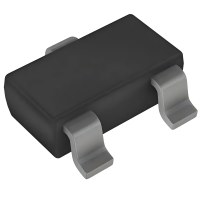Core function: Provide stable reference voltage or perform voltage clamping.
Zener diode is a special type of diode that cleverly utilizes its reverse breakdown characteristic. Unlike ordinary diodes that mainly utilize forward conduction characteristics, voltage regulators are specifically designed to operate in the reverse breakdown region.

The specific functional logic is as follows:
Reverse breakdown characteristic: When a reverse voltage is applied to a voltage regulator diode and this voltage exceeds its specific "Zener voltage" or "breakdown voltage" (Vz), the diode will undergo "breakdown".
Key point: Controllable breakdown: Ordinary diodes can be damaged by breakdown, but the design of the voltage regulator diode allows it to safely and controllably pass a large reverse current (Iz) in the breakdown state, while maintaining the reverse voltage at both ends almost constant around the Vz value.
Voltage clamping/stabilization mechanism:
Voltage clamping: When a voltage regulator diode is connected in parallel to two points in a circuit (usually the two ends of the load that needs protection or the node that needs stable voltage):
If the voltage at this point is lower than the Vz value of the diode, the diode is in a reverse cutoff state, which is equivalent to an open circuit and has no effect on the circuit.
Once the voltage at that point attempts to rise above the Vz value, the voltage regulator diode immediately enters a breakdown state.
In the breakdown state, the diode will absorb (shunt) additional current (through changes in its own impedance), thereby preventing the voltage at that point from further increasing and "clamping" it near the Vz value.
Provide stable reference voltage: When a voltage regulator diode is used in conjunction with a suitable current limiting resistor (connected in series between the power supply and the diode), even if the input power supply voltage (Vin) fluctuates within a certain range or the load current (IL) changes, due to the voltage regulation characteristics of the diode in the breakdown region, its cathode (or anode, depending on the grounding method) can output a relatively stable voltage at Vz value (Vout ≈ Vz). The function of a current limiting resistor is to ensure that the current flowing through the diode is within a safe range and to provide a voltage drop to 'digest' fluctuations in the input voltage.
Image metaphor: A voltage regulator diode can be imagined as a "voltage anchor". When the voltage attempts to 'float away' (rise) beyond the set value (Vz), this' anchor 'will' sink '(breakdown), generating a strong' grip '(shunt current), pulling the voltage back and firmly fixing it near the set point.
Summarize the key role of voltage regulator diodes:
Voltage stabilizer: provides a precise and stable reference voltage source (Vout=Vz) for circuits in simple, low-power applications.
Voltage clamp/protector: prevents the voltage on circuit nodes from exceeding the safe threshold (Vz), and protects sensitive electronic components (such as IC pins, MOSFET gates, etc.) from overvoltage damage.
Voltage reference source: used as a comparator ADC、 The core component of circuits that require precise voltage reference, such as voltage regulator ICs.
Important features and limitations:
Simple and inexpensive: Implementing voltage regulation/clamping functions is very economical.
Limited power: The current and power consumption that can be processed are relatively small, mainly used in small signal or low-power situations.
Accuracy and temperature: Voltage stability is affected by its own accuracy, operating current (within the recommended range), and temperature (with temperature coefficient).
Need for current limiting: A current limiting resistor must be connected in series, otherwise the current will increase infinitely during breakdown, leading to burnout.
Simply put, a voltage regulator diode is like a 'voltage goalkeeper'. It usually does not interfere (reverse cutoff), but once it detects a voltage attempting to cross its guarded "gate line" (Vz value), it immediately "extinguishes" (reverse breakdown), shunting excess energy by changing its own "resistance" (dynamic resistance), striving to firmly control the voltage value near the gate line (Vz), thereby stabilizing the voltage or limiting excessive voltage.
I hope this original explanation logic clearly elucidates the core value of the voltage regulator diode! Do we need to further explore its application circuit examples?
